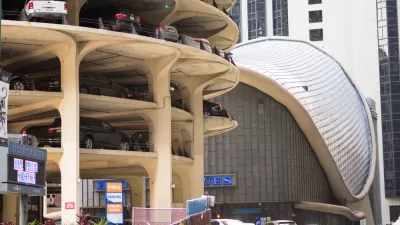It’s not just those buff lifeguards. Most coastal and Great Lakes states have a coastal zone management program. And not only are the coastal zone managers watching the beach, they are watching what’s being built in their communities. In fact, in recent interviews of coastal zone managers, 56 out of 58 said growth was the top pressure on coastal resources in their state.
It's not just those buff lifeguards. Most coastal and Great Lakes states have a coastal zone management program. And not only are the coastal zone managers watching the beach, they are watching what's being built in their communities. In fact, in recent interviews of coastal zone managers, 56 out of 58 said growth was the top pressure on coastal resources in their state.
Why are the coastal zone managers so worried about growth? A 2005 report released by the National Oceanic Atmospheric Administration estimated that coastal counties cover less than 17 percent of the land area in the United States, but are home to 53 percent of the population. Within 10 years, that population is expected to grow by 12 million people-or by 3,600 people per day. Not only do these communities need more lifeguards, they need more people paying attention to how these coastal communities are growing.
The coastal zone management program was created under the Coastal Zone Management Act (CZMA), which balances the protection and economic uses of our coastal resources. Congress will soon be debating CZMA funding levels and program components and there may be bills that seek to establish a coastal community program, which will provide assistance to communities to address the impacts of growth on coastal resources.
I think it's a good sign that the wide range of players whose job it is to protect coastal resources understand that one critical aspect to protecting the beach, the coast, and all the critters in the water is paying attention to what happens on land. If your job is to protect the habitat of an aquatic species, addressing issues of where and how growth occurs in the areas near or adjacent to the coast naturally becomes part of your job description.
I don't think, however, coastal zone managers-or the federal agencies responsible for assisting these state programs-need to wait for additional funding from Congress to better address growth and development issues. Right now there is considerable flexibility in the federal and state guidelines for coastal zone management funding. Local and state coastal programs can reallocate some of their existing resources to better engage on growth issues in their communities.
For example, coastal zone programs could look at a community's land development regulations, or the rules that govern development, to determine how redevelopment of already degraded areas, such as a abandoned parking lot, is treated. Are there incentives or disincentives for the developer to redevelop this property? Incentives can take the form of different stormwater requirements, density bonuses, local support for infrastructure, or streamlined permitting. The more a community can create incentives to direct the coming growth to areas that are already degraded, such as vacant properties, abandoned parking lots, or underutilized buildings or shopping centers, the more coastal resources will be protected as the net environmental impact from growth is reduced or maybe even eliminated.
A coastal zone program could also work with a community to look at street and road design guidelines and parking requirements. Streets, roads, and parking can create large swathes of impervious cover, which can create significant runoff that can degrade our beaches and shorelines. Many communities have found that one successful strategy for reducing hard surfaces is to assess street and road design guidelines and parking lot design. Coastal zone managers could work with communities to revise parking requirements to encourage more shared parking between complimentary uses. Reducing parking supply could reduce total impervious cover in a community.
The bottom line facing coastal communities-and coastal zone managers-is how to balance the opportunities the coming growth provides to these communities while protecting and respecting the very resources that made these communities attractive-our stunning beaches and coastlines. We may very well find that our coastal managers are just as important to our wellbeing as those lifeguards.

Planetizen Federal Action Tracker
A weekly monitor of how Trump’s orders and actions are impacting planners and planning in America.

Chicago’s Ghost Rails
Just beneath the surface of the modern city lie the remnants of its expansive early 20th-century streetcar system.

San Antonio and Austin are Fusing Into one Massive Megaregion
The region spanning the two central Texas cities is growing fast, posing challenges for local infrastructure and water supplies.

Since Zion's Shuttles Went Electric “The Smog is Gone”
Visitors to Zion National Park can enjoy the canyon via the nation’s first fully electric park shuttle system.

Trump Distributing DOT Safety Funds at 1/10 Rate of Biden
Funds for Safe Streets and other transportation safety and equity programs are being held up by administrative reviews and conflicts with the Trump administration’s priorities.

German Cities Subsidize Taxis for Women Amid Wave of Violence
Free or low-cost taxi rides can help women navigate cities more safely, but critics say the programs don't address the root causes of violence against women.
Urban Design for Planners 1: Software Tools
This six-course series explores essential urban design concepts using open source software and equips planners with the tools they need to participate fully in the urban design process.
Planning for Universal Design
Learn the tools for implementing Universal Design in planning regulations.
planning NEXT
Appalachian Highlands Housing Partners
Mpact (founded as Rail~Volution)
City of Camden Redevelopment Agency
City of Astoria
City of Portland
City of Laramie




























